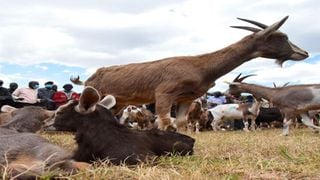
Dairy goats during an auction at Chebororwa Agriculture Training Centre in Moiben, Uasin County, on February 4, 2021. Goats are among animals that are prone to the skin disease.
| FileSeeds of Gold
Premium
Dermatophilosis: Animal skin disease many farmers miss
I recently visited a farm in Murang’a to treat a cow with a large boil or abscess on the shoulder and a goat with a heavily swollen eye.
One of my colleagues had treated the goat a week earlier. The owner said there had been initial improvement on the eye but after about five days, the swelling had recurred. The eye had almost closed and kept discharging tears and pus.
On arrival at the farm, I quickly dispensed with opening of the abscess and cleaning with iodine and hydrogen peroxide. I then gave a long-acting antibiotic injection and covered the wound with antibiotic and fly repellent spray.
I then moved to the sick goat. Examination showed it had pink eye disease that is caused by bacteria. From the history given, it appeared to me the infection must have been caused by mixed bacteria, some of which were resistant to the initial antibiotic used.
I thought so because I saw signs of healed wounds on the cornea while new wounds had recently developed. The colour of pus was also uniform beige.
I injected the goat with a long-acting antibiotic under the inner side of the eyelid. We call it subconjunctival injection.
During the injection, I noticed the goat’s hair was thin from the neck to the hips on both sides of the body. The skin in the affected area had thickened and some areas had cracks. I was informed the goat, together with another one, had recently been brought into the farm from the same source two weeks before. I checked the other goat and made the same observation. Both goats were also in poor body condition.
The animal attendant told me they had not noticed the skin problem since the goats were not scratching. They thought the poor body condition was due to poor feeding prior to coming to the farm.
I examined all the 20 sheep and goats in the unit and confirmed only the two newcomers had the skin problem. They must have come in with the infection as it takes time for the skin to thicken, crack and some hair to fall off.
The kind of skin disease I observed may be caused by several micro-organisms. It could be fungal, bacterial, parasitic or viral infection. Each of these disease-causing organisms or pathogens have specific characteristics in their infection outcomes.
In this case, the skin thickening was fairly uniform and greyish with cracks. There was no scratching and only some hairs had fallen off. I could have taken samples for laboratory analysis but then, the farm manager said he did not wish to incur expenses on laboratory diagnosis unless treatment on clinical diagnosis failed to resolve the problem. This is a common option with farmers as they try to minimise the cost of production.
I diagnosed a bacterial infection called dermatophilosis or streptothricosis. It is caused by a bacterial species called Dermatophilus congolensis. I injected both goats with a long-acting antibiotic into the muscles. I also advised the animal attendant to wash the affected areas with an iodine solution twice a week until the skin had fully recovered. It takes about three weeks for the problem to resolve.
Due to its lack of itching and gentle loss of hair, dermatophilosis is often missed by farmers and their workers until it is too late when affected animals lose weight continuously despite feeding well. If the disease is widely spread on the skin with heavy thickening, affected animals may have to be destroyed.
The disease affects all farm animals and pets. It may affect humans as well. In sheep, it is also called lumpy wool because it causes matting of the wool.
The bacteria may be found on normal skin but they proliferate and cause infection when conditions are favourable. Humans handling infected animals should wear gloves and wash their hands and arms with antibacterial soap or solutions to prevent infection.
It is also thought that some animals have genes that make them more easily infected by the bacteria. For this reason, animals that have recurring infection should not be bred to eliminate their weak genes and, therefore, control the disease.
Warm wet weather and suppression of the immunity are other factors that encourage development of the infection.
In cattle, the farmer may see some raised hair tufts on the skin, especially on the top hip area. The skin may also appear greasy and the hair falls off when rubbed or combed. Mild infections may heal on their own but where the skin has thickened, the disease should be treated to prevent increased skin damage and spread to other animals. The disease is spread through contact, injury to the skin and suppression of immunity by chemicals in the saliva of ticks.
Fortunately, dermatophilosis is mostly a mild disease and it responds well to treatment with a variety of antibiotics. By the time of publishing this article, all the animals were recovering well but the goats would need a second antibiotic injection.





